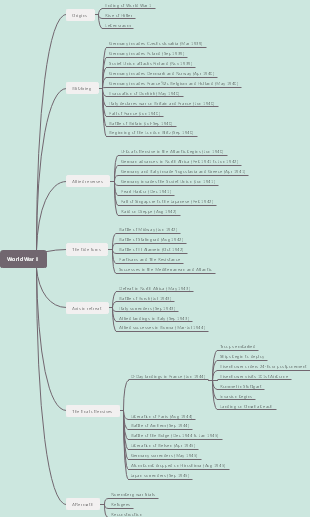MindMap Gallery The History Of Visual Communication
- 98
- 1
The History Of Visual Communication
This is a mind map about "The History Of Visual Communication".
Edited at 2020-12-23 09:33:24- Recommended to you
- Outline
The History Of Visual Communication
The Printing Press
Johannes Gutenberg
motivation: love of books &spending time with father at the mintwatching goldsmiths and jewelers
created oilbased ink
experimented w/ metal topography
introduced modern book printing
agreement w/ John Fust stated that ifGutenberg couldn't repay the loan after 5 years,Fust could get the press, tools, and materials
agreement violated and Fust andSchoeffer took credit for the press
hand press in which ink isrolled over the raised surfaceof movable handset lettersheld within a wooden frame
Movable Type
1st movable type system developed in China
carved from wood
Advantages of metal or wood
could be produced quicker once single moldwas made
was quicker, more durable, and lettering wasmore uniform
Gutenberg made metal type out of an alloy oflead, tin, and antimony
Bible: 1st book to be printed
Major Printing Processes
Relief
Intalgio
Porous
Lithoography
The Linotype Machine
invented by Christopher Sholes
tested by Clephane
name comes from the fact that it produces anentire line of metal type at once
first installed in The New York Tribune
Keyboard Layout
90 character keyboard
arrangment based on letter frequency
upper/lowercase keys were separate (no shiftkey
Black key: lowercase; White key: uppercase;Blue key: punctuation, digits, etc.
Sumerians
Cuneiform
to help keep track ofbusiness transactions
began as a series of pictographs
Evolution
became more abstract
# of characters grew
characters became wedge shaped
chose sumer region tosettle b/c of fertile ground
Things we know
Theocratic cultureruled by a priest king
skilled artisans
music=important part of life
Cave Paintings 55,000 years ago
common themes: largeanimals, tracings ofhuman hands, abstractpatterns
first form of visual communication
cave painting sites
Lascaux
closed b/c paintingswere being damaged bycarbon dioxide emittedfrom tourists
created the Lascaux II
most famous cavepainting site
located in France
Almira cave
has a red hue b/c of red soil
located in Spain
discovered by Marcelino
Chauvet Pont d’Arc
painting techniques differentb/c 3D effect was created
Photography
Camera Obscura
Joseph Niepce created 1stsuccessful photograph
Daguerreotype
created by Louis Daguerre
image was exposed to a lightsensitive metalsheet
Calotype Process
created by William Fox Talbot
image was exposed onto a light sensitivepaper producing a paper negative
Wet Plate Process
created by Archer
glass plates were used for the negative tocapture the image when exposed to light
Dry Plate Process
created by Richard Maddox
glass plates coated in gelatin
gelatin: a colorless watersoluble glutinousprotein obtained from animal tissue
Kodak
established by Eastman
James Clerk Maxwell took 1st color photograph
Muybridge paved the way for motion picturephotography
zoopraxiscope: a device used to project a seriesof images in successive phases of motion
Computers
Univac= 1st commercial computer
created by John Preseper Eckert and JohnMauchly
letters stand for Universal Automatic Computer
IBM
letters stand for International BusinessMachine
developed IBM701 EOPM Computer
developed first memory disk(floppy disk)
Douglas Engelbart invented the mouse
named mouse b/c of the tail connected tothe computer
first internet= ARPANET
developed to protect flow of info b/w militaryinstallations
first memory disk= floppy disk
Apple
introduced Apple Lisa in 1983
1st PC with a GUI
GUI developed by Xerox
introduced Apple Macintosh Computer in 1984
Microsoft
introduced MSDOS
a computer operating system
introduced Windows in response to Apple'soperating system
The Book
Scrolls
Construction
long continuouspieces of papyrus
separate sheets gluedtogether at the edges
simply rolled or hadwooden rollers at each end
Codex
Definition:a covered and boundcollection of hand written pages
Advantagesover scroll
compact,sturdy, and ease if reference
can be opened flat to any page
easier use in libraries b/c titlecould be written on the spine
adopted byChristianity
used in churches for Bibles and scriptures
Parchment
Definition:a substratemade from animal skins
replaced papyrus b/cwas more durable
How to make it
1. remove hair and fat and smooth the skin
2. soak hide in water solution; calcium, flour, salt added
3. hide stretched out, flattened, and dried
IlluminatedManuscripts
word illumination refers tothe borders, illustrations,and ornamentation added toeach page of text
reserved for religious textsb/c were so laborious
creation of illuminated manuscriptsdeclined b/c of printing press
The Egyptians
Tombs, Great pyramids, temples
Hieroglyphics
Rosetta Stone
Deciphered byJean FrancoisChampollion
has 3 languages: Greek,Demotic, Heiroglyphics
resides in the British Museum
contained logographicand alphabetic elements
logogram: visual symbolsrepresenting ideas or objects
derived from 2 Greek words hiero meaningsacred and glyphic meaning engraving/writing









